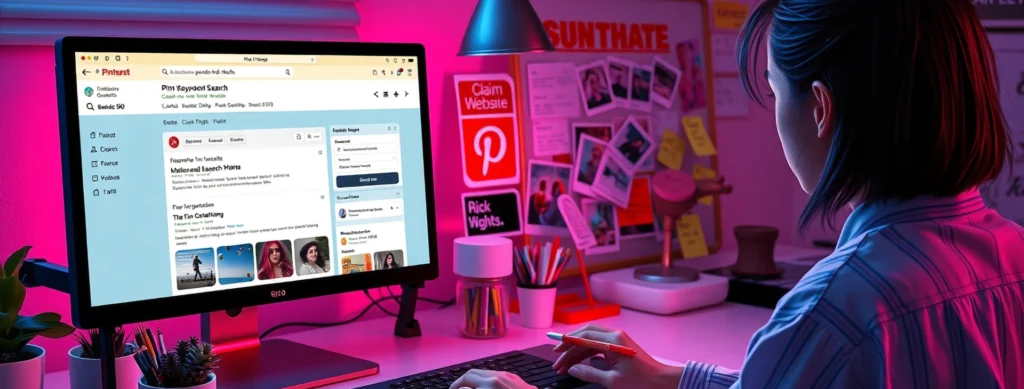
Pinterest SEO is crucial if you want your pins to be found by the right audience. As Pinterest keeps changing, mastering these SEO strategies will make sure your content ranks well in searches. This helps more users see your pins. This beginner-friendly guide walks you through everything you need to know to optimize your Pinterest presence in 2025. It will cover how to optimize Pinterest pins and boost your Pinterest traffic growth.
Transparency Matters
This article contains affiliate links. When you click on these links and make a purchase, we may earn a small commission at no additional cost to you. We only recommend products and services that we have personally tested or thoroughly researched and believe will provide genuine value to our readers. Your support helps us maintain this site and continue creating valuable content.
Why Pinterest SEO Matters So Much for You
Pinterest acts like both a social platform and a powerful search engine. This is why proper Pinterest SEO techniques are so important. They can help your pins appear in relevant search queries, which then increases traffic to your blog or online store. Think of it this way: if your pins aren’t optimized, they’re like hidden gems no one can find.
When I started really focusing on Pinterest SEO, I saw my blog traffic jump significantly. It’s truly an effective way to connect with people who are already looking for content like yours.
1. Smart Keyword Research on Pinterest
Keyword research is the foundation of effective Pinterest SEO. It’s how you understand what your audience is searching for.
Here’s how to do your Pinterest keyword research:
- Use Pinterest’s search bar: Start typing a topic related to your niche. Pinterest will suggest popular keywords and phrases. These are gold mines because they show actual user search intent.
- Look at suggested phrases and related searches: After you search, Pinterest often displays additional relevant terms. Scroll down to see “Related searches” and “More ideas” sections. This helps you find long-tail keywords.
- Explore Pinterest Trends: This official tool can help uncover high-traffic keywords over time. It shows what’s gaining popularity, letting you create timely content. You can also use third-party tools to help you find more keywords.
- Naturally include keywords: Once you have your keywords, use them in your pin titles, descriptions, and board titles. Make sure they fit naturally within the text. Avoid just listing keywords.
When I first started, I used to just guess at keywords. Once I began doing proper Pinterest keyword research, my pin impressions went through the roof. It makes a huge difference.
2. Optimize Your Pin Titles for Clicks
Your pin title is one of the first things Pinterest’s algorithm and users see. It’s vital for good Pinterest SEO. Create clear, descriptive titles that include your target keywords. This helps Pinterest understand what your content is about. Then, it can match your pin with relevant searches.
A strong title grabs attention and encourages clicks. For instance, instead of just “Recipe,” try “Easy Gluten-Free Banana Bread Recipe for Beginners.” See how the second one is much more specific and keyword-rich?
3. Write Keyword-Rich Pin Descriptions
Pin descriptions provide more context for your pins. They are also a key part of how to optimize Pinterest pins. Use your researched keywords throughout the description. However, always keep the text engaging and easy to read. Avoid “keyword stuffing,” which means cramming too many keywords unnaturally. This can hurt your visibility.
Aim for a conversational tone. Describe what the user will gain by clicking on your pin. Think of your description as a mini-blog post that entices the reader.
4. Use Relevant Hashtags Strategically
Hashtags are still very useful on Pinterest. They increase your pin’s discoverability. Use a few relevant hashtags in your description. Make sure they align with your keywords and your target audience’s interests.
I recommend using a mix of broad and specific hashtags. For example, if your pin is about “vegan meal prep,” you might use #veganrecipes (broad) and #weeklymealprepideas (specific).
5. Optimize Your Board Titles and Descriptions
Boards are where your pins live and are organized. Therefore, optimizing them is a crucial element of Pinterest SEO. Make sure your board titles and descriptions also include important keywords. This helps your boards appear in search results, making it easier for users to find your grouped content.
Treat your boards like mini-categories for your content. If you have a board called “Healthy Eating,” its description could include keywords like “healthy meal ideas,” “nutritious recipes,” and “clean eating tips.”
6. Pin Consistently and at Optimal Times
Pinterest rewards active pinners. Consistent pinning significantly improves your account’s overall visibility and signal to the platform that you are a valuable content creator. This is a vital Pinterest SEO tip.
Use Pinterest’s analytics (or third-party scheduling tools) to find out when your audience is most active. Pinning when your audience is online increases the chances of immediate engagement. I’ve noticed a real difference in engagement when I share content during peak times for my followers.
7. Use High-Quality, Vertical Images
Visually appealing images are at the heart of Pinterest’s appeal. Pins with eye-catching, vertical images generally perform much better than horizontal ones. Ensure your images are clear, highly relevant to your content, and follow Pinterest’s recommended dimensions (a 2:3 aspect ratio, typically 1000 x 1500 pixels, is ideal).
High-quality visuals capture attention as users scroll, encouraging them to stop, save, and click through your pin. This directly impacts your Pinterest traffic growth.
8. Engage with Your Audience Regularly
Pinterest isn’t just a search engine; it’s also a community. Responding to comments on your pins and engaging with other pinners helps build a strong community around your content. This encourages more interaction with your pins, which can signal to Pinterest that your content is valuable and relevant.
When users save, comment on, or click your pins, it tells Pinterest that your content resonates. This positive engagement can boost your pins’ visibility in searches, further aiding your Pinterest traffic growth.
Additional Resources to Master Pinterest SEO:
To deepen your understanding and fine-tune your Pinterest strategy, consider these valuable resources:
- Pinterest Keyword Research Guide: Dive deeper into finding the best keywords for your niche.
- Pinterest Pin Design Tips: Learn the secrets to creating visually stunning and effective pins.
- Schedule Pinterest Pins for Maximum Visibility: Discover tools and strategies for consistent, timely pinning.
FAQ: Pinterest SEO for Beginners
Here are answers to common questions about Pinterest SEO, especially for those just starting out in 2025.
What is Pinterest SEO?
Pinterest SEO is the process of optimizing your pins, boards, and profile so they rank higher in Pinterest’s search results and reach a wider audience.
How do I find the best keywords for Pinterest?
Use Pinterest’s own search bar suggestions, the guided search features, and Pinterest Trends to discover popular keywords related to your niche and content.
How many keywords should I use in a pin description?
Aim to naturally integrate 3-5 highly relevant keywords within your pin description. Focus on readability first.
Do hashtags help on Pinterest?
Yes, relevant hashtags absolutely help on Pinterest. They improve your pin’s discoverability, especially in the initial hours after publishing.
What image size works best for Pinterest?
Vertical images with a 2:3 aspect ratio perform best. This typically means dimensions like 1000 pixels wide by 1500 pixels tall.
How often should I pin on Pinterest?
Aim for consistent pinning. Daily pinning or several times a week is a good strategy to maintain activity and visibility.
Can Pinterest SEO increase my blog traffic?
Absolutely! Proper Pinterest SEO helps your pins get seen by a larger, more targeted audience, which directly drives more referral traffic back to your blog or website.
Should I engage with other users on Pinterest?
Yes, engagement is important. Responding to comments and interacting with other users helps build your community and can increase your pins’ overall visibility and reach.
Final Thoughts: Your Pinterest SEO Journey
Mastering Pinterest SEO 2025 will significantly boost your pin visibility and help achieve your Pinterest traffic growth goals. Remember to learn about Pinterest keyword research to find what your audience wants. Focus on how to optimize Pinterest pins with strong titles, rich descriptions, and relevant hashtags.
Success in this area demands dedication and consistent effort, but by following these strategies, you will undoubtedly achieve the rewarding results you’re seeking within 3-6 months.
Ready to take your pin design to the next level? Learn essential Pinterest Pin Design Tips →


